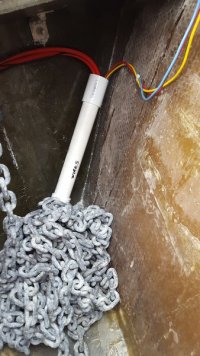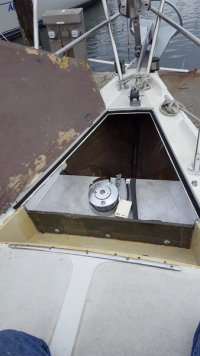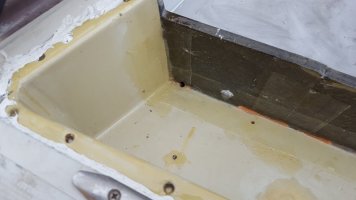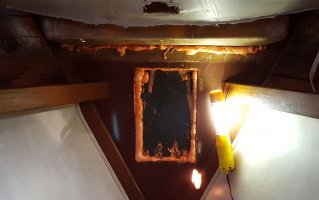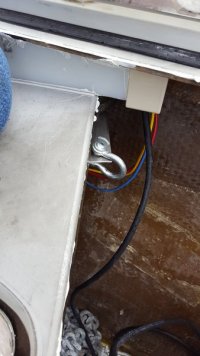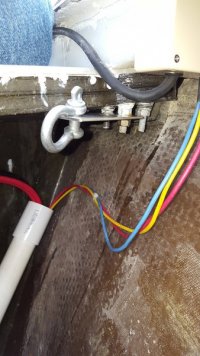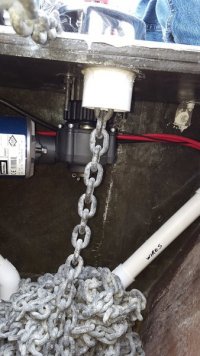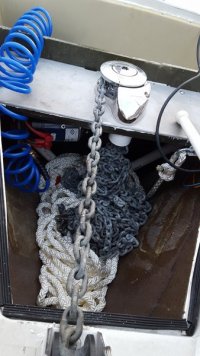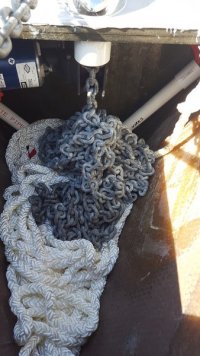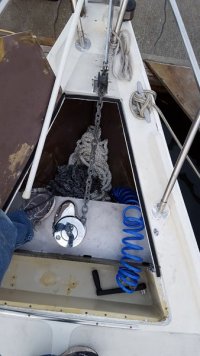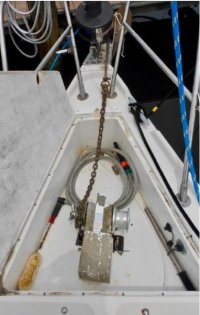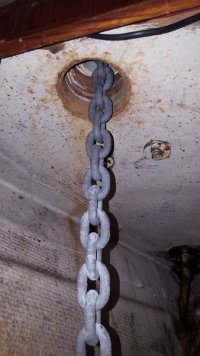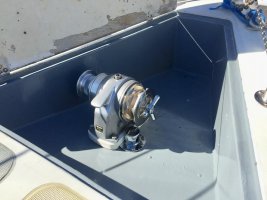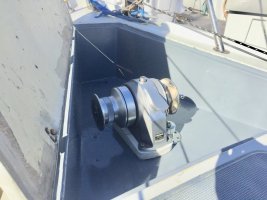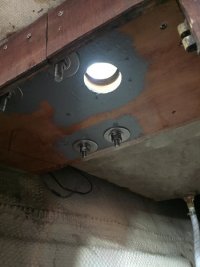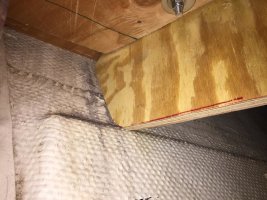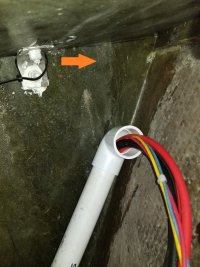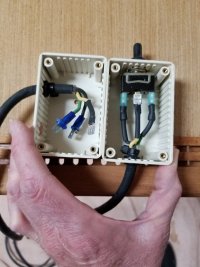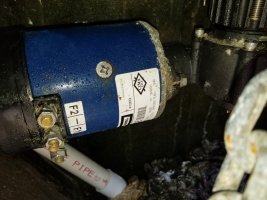Troubleshooting
The windlass shelf has been permanently in place for a few days and the windlass is installed probably for good, at least as far as the deckplate goes. Initial testing of the operation has been done with the bow overhanging the dock, with the chain and anchor only. A couple issues have arisen and a question has come up regarding the fit of the motor and gearbox to the deckplate's spacer tube.
Should there be any play between gearbox and the spacer tube after the plastic locknut is tight? I was assuming that there would be none, but there seems to be a little rotation play in the castellations and a tiny amount of tilt play. The locknut is as tight as I can get it by hand. It doesn't seem to matter which direction the collar under the locknut is oriented. There is no cross-threading. I also greased the locknut and gearbox threads. In the low-weight testing there isn't any noticeable problem, but it is something I need to resolve as "OK" or not. The end of the shaft is at the right place to fit the key and retainer spring.
The issues that have come up are with the anchor roller and anchor interface. The first thing that was evident was that the galvanized shackle pin is too long for the space between the vertical plates of the roller. This situation, even if manually corrected when the anchor reaches the roller, is not going to work with that shackle and its pin, because the stock of the rudder can get caught between the vertical plates. That jams the anchor there and stalls the windlass. That is not a workable situation.
After a nice meal and an evening looking at the differences between my roller, the old bronze roller, and the updated roller on the younger E38s, we came to the conclusion that the new roller was going to be OK without any major surgery. Naturally, the biggest initial fear was that the roller would have to come off to be modified or replaced. The first thing we did was find a new shackle and try it. We looked at swivels and there are a couple (less expensive ones) that would fit, but the recommended one (expensive) was too fat for the roller. I'd rather avoid a swivel anyway. We found a stainless Wichard 1305 shackle with the allen-head pin. The dock tests with that shackle are very encouraging and we may progress to wet-anchor testing with that change only.
The old roller never gave us problems in manual operation and it is easy, with hindsight, to see why. The roller vertical plates, although closer together than mine, are low and aft, with respect to the roller wheel itself. The wheel is right there at the front of the plates and has its orienting and twisting effect on the anchor stock before the stock reaches the narrow area behind it. Likewise, on the newer E38, a wider plate spacing and roller would allow the shackle to pass and anchor stock to come aboard and twist as needed.
If further testing shows that it is necessary to make more changes, then we'll deal with that and post the results. In the meantime I've decided to make some adjustment to the standpipes for the washdown pump hose and windlass wiring, and complete the chafe guard for the gearbox.
The old shackle and new shackle.
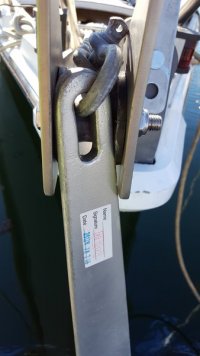
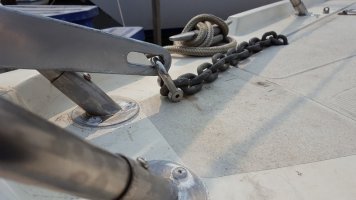
Old roller
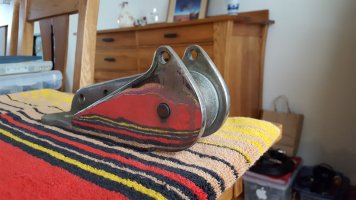
The windlass shelf has been permanently in place for a few days and the windlass is installed probably for good, at least as far as the deckplate goes. Initial testing of the operation has been done with the bow overhanging the dock, with the chain and anchor only. A couple issues have arisen and a question has come up regarding the fit of the motor and gearbox to the deckplate's spacer tube.
Should there be any play between gearbox and the spacer tube after the plastic locknut is tight? I was assuming that there would be none, but there seems to be a little rotation play in the castellations and a tiny amount of tilt play. The locknut is as tight as I can get it by hand. It doesn't seem to matter which direction the collar under the locknut is oriented. There is no cross-threading. I also greased the locknut and gearbox threads. In the low-weight testing there isn't any noticeable problem, but it is something I need to resolve as "OK" or not. The end of the shaft is at the right place to fit the key and retainer spring.
The issues that have come up are with the anchor roller and anchor interface. The first thing that was evident was that the galvanized shackle pin is too long for the space between the vertical plates of the roller. This situation, even if manually corrected when the anchor reaches the roller, is not going to work with that shackle and its pin, because the stock of the rudder can get caught between the vertical plates. That jams the anchor there and stalls the windlass. That is not a workable situation.
After a nice meal and an evening looking at the differences between my roller, the old bronze roller, and the updated roller on the younger E38s, we came to the conclusion that the new roller was going to be OK without any major surgery. Naturally, the biggest initial fear was that the roller would have to come off to be modified or replaced. The first thing we did was find a new shackle and try it. We looked at swivels and there are a couple (less expensive ones) that would fit, but the recommended one (expensive) was too fat for the roller. I'd rather avoid a swivel anyway. We found a stainless Wichard 1305 shackle with the allen-head pin. The dock tests with that shackle are very encouraging and we may progress to wet-anchor testing with that change only.
The old roller never gave us problems in manual operation and it is easy, with hindsight, to see why. The roller vertical plates, although closer together than mine, are low and aft, with respect to the roller wheel itself. The wheel is right there at the front of the plates and has its orienting and twisting effect on the anchor stock before the stock reaches the narrow area behind it. Likewise, on the newer E38, a wider plate spacing and roller would allow the shackle to pass and anchor stock to come aboard and twist as needed.
If further testing shows that it is necessary to make more changes, then we'll deal with that and post the results. In the meantime I've decided to make some adjustment to the standpipes for the washdown pump hose and windlass wiring, and complete the chafe guard for the gearbox.
The old shackle and new shackle.


Old roller

Last edited:

